Hitachi H 45MR User Manual
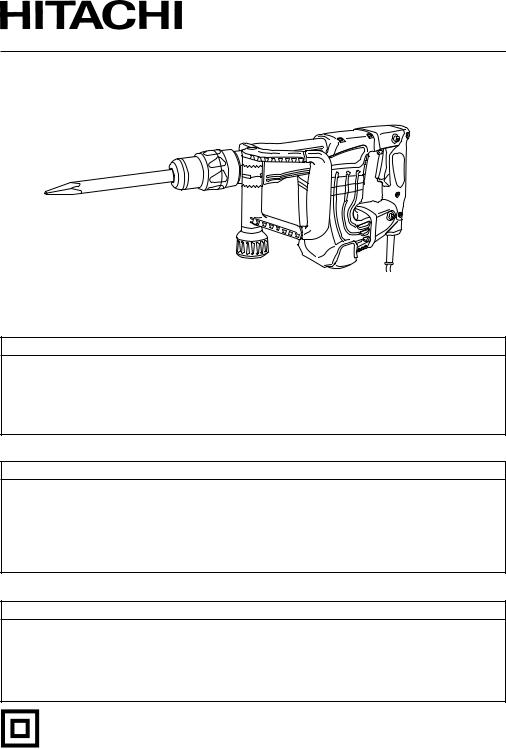
Model |
H 45MR |
Demolition Hammer |
Modèle |
Marteau piqueur |
|
Modelo |
|
Martillo demoledor |
SAFETY INSTRUCTIONS AND INSTRUCTION MANUAL
 WARNING
WARNING
IMPROPER OR UNSAFE use of this power tool can result in death or serious bodily injury!
This manual contains important information about product safety. Please read and understand this manual BEFORE operating the power tool. Please keep this manual available for other users and owners before they use the power tool. This manual should be stored in safe place.
INSTRUCTIONS DE SECURITE ET MODE D’EMPLOI
 AVERTISSEMENT
AVERTISSEMENT
Une utilisation INCORRECTE OU DANGEREUSE de cet outil motorisé peut entraîner la mort ou de sérieuses blessures corporelles!
Ce mode d’emploi contient d’importantes informations à propos de la sécurité de ce produit. Prière de lire et de comprendre ce mode d’emploi AVANT d’utiliser l’outil motorisé. Garder ce mode d’emploi à la disponibilité des autres utilisateurs et propriétaires avant qu’ils utilisent l’outil motorisé. Ce mode d’emploi doit être conservé dans un endroit sûr.
INSTRUCCIONES DE SEGURIDAD Y MANUAL DE INSTRUCCIONES
 ADVERTENCIA
ADVERTENCIA
¡La utilización INAPROPIADA O PELIGROSA de esta herramienta eléctrica puede resultar en lesiones de gravedad o la muerte!
Este manual contiene información importante sobre la seguridad del producto. Lea y comprenda este manual ANTES de utilizar la herramienta eléctrica. Guarde este manual para que puedan leerlo otras personas antes de utilizar la herramienta eléctrica. Este manual debe ser guardado en un lugar seguro.
DOUBLE INSULATION |
|
DOUBLE ISOLATION |
|
AISLAMIENTO DOBLE |
1 |

English
|
|
|
CONTENTS |
|
|
|
||||
English |
|
|
|
|
|
|||||
|
|
|
|
|
|
|
|
|
||
|
Page |
ASSEMBLY |
Page |
|||||||
|
|
|
||||||||
IMPORTANT SAFETY INFORMATION ...... |
3 |
10 |
||||||||
MEANINGS OF SIGNAL WORDS .............. |
3 |
OPERATION |
12 |
|||||||
|
|
|
|
|
||||||
SAFETY ............................................................ |
|
|
4 |
APPLICATIONS ......................................... |
12 |
|||||
GENERAL SAFETY RULES ......................... |
|
|
4 |
PRIOR TO OPERATION ............................. |
12 |
|||||
SPECIFIC SAFETY RULES AND |
|
HOW TO USE THE DEMOLITION |
|
|||||||
SYMBOLS .............................................. |
|
|
6 |
|
HAMMER ............................................. |
13 |
||||
DOUBLE INSULATION FOR SAFER |
|
|
|
|
|
|
||||
OPERATION .......................................... |
|
|
8 |
MAINTENANCE AND INSPECTION ............. |
14 |
|||||
FUNCTIONAL DESCRIPTION ......................... |
|
|
9 |
ACCESSORIES .............................................. |
16 |
|||||
NAME OF PARTS ........................................ |
|
|
9 |
STANDARD ACCESSORIES ..................... |
16 |
|||||
SPECIFICATIONS ........................................ |
|
|
9 |
OPTIONAL ACCESSORIES ....................... |
16 |
|||||
|
|
|
|
|
PARTS LIST ................................................... |
48 |
||||
|
|
|
|
|
|
|
|
|||
|
|
|
|
|
||||||
|
|
TABLE DES MATIERES |
|
|
||||||
Français |
|
|
|
|||||||
|
|
|
|
|
|
|
|
|
||
|
Page |
ASSEMBLAGE |
Page |
|||||||
|
|
|
||||||||
INFORMATIONS IMPORTANTES DE |
|
25 |
||||||||
SÉCURITÉ ............................................ |
|
|
18 |
FONCTIONNEMENT |
|
|||||
SIGNIFICATION DES MOTS |
|
|
|
27 |
||||||
D’AVERTISSEMENT ........................... |
|
|
18 |
APPLICATIONS ......................................... |
27 |
|||||
SECURITE |
|
|
|
AVANT L’UTILISATION ............................ |
27 |
|||||
|
|
19 |
COMMENT UTILISER LE MARTEAU |
|
||||||
REGLES GENERALES DE SECURITE ....... |
19 |
|
PIQUEUR ............................................. |
28 |
||||||
REGLES DE SECURITE SPECIFIQUES |
|
ENTRETIEN ET INSPECTION |
|
|||||||
ET SYMBOLES .................................... |
|
|
21 |
29 |
||||||
DOUBLE ISOLATION POUR UN |
|
ACCESOIRES |
|
|||||||
FONCTIONNEMENT PLUS SUR ........ |
23 |
31 |
||||||||
|
|
|
|
|
ACCESSOIRES STANDARD ..................... |
31 |
||||
DESCRIPTION FONCTIONNELLE ................ |
24 |
ACCESSOIRES SUR OPTION ................... |
31 |
|||||||
NOM DES PARTIES .................................. |
|
|
24 |
|
|
|
|
|
||
SPECIFICATIONS ...................................... |
|
|
24 |
LISTE DES PIECES ........................................ |
48 |
|||||
|
|
|
|
|
|
|
|
|||
|
|
|
|
|
|
|
||||
|
|
|
|
ÍNDICE |
|
|
|
|
||
Español |
|
|
|
|
|
|||||
|
|
|
|
|
|
|
|
|
||
Página |
|
|
|
|
Página |
|||||
|
|
|
|
|
|
|||||
INFORMACIÓN IMPORTANTE SOBRE |
|
MONTAJE ..................................................... |
40 |
|||||||
SEGURIDAD ........................................ |
|
|
33 |
|
|
|
|
|
||
SIGNIFICADO DE LAS PALABRAS DE |
|
OPERACIÓN .................................................. |
42 |
|||||||
SEÑALIZACIÓN ................................... |
|
|
33 |
APLICACIONES ......................................... |
42 |
|||||
|
|
|
|
|
ANTES DE LA OPERACIÓN ...................... |
42 |
||||
SEGURIDAD .................................................. |
|
|
34 |
FORMA DE USAR EL MARTILLO |
|
|||||
NORMAS GENERALES DE SEGURIDAD |
34 |
|
DEMOLEDOR ...................................... |
43 |
||||||
NORMAS.............................................................Y SÍMBOLOS ESPECÍFICOS |
MANTENIMIENTO E INSPECCIÓN |
44 |
||||||||
|
||||||||||
DE SEGURIDAD .................................. |
|
|
36 |
|
|
|
|
|
||
AISLAMIENTO DOBLE PARA OFRECER |
|
ACCESORIOS ................................................ |
46 |
|||||||
UNA OPERACIÓN MÁS SEGURA ..... |
38 |
ACCESORIOS ESTÁNDAR ....................... |
46 |
|||||||
DESCRIPCIÓN FUNCIONAL |
|
|
39 |
ACCESORIOS OPCIONALES .................... |
46 |
|||||
|
|
LISTA DE PIEZAS |
|
|||||||
NOMENCLATURA ..................................... |
|
|
39 |
48 |
||||||
ESPECIFICACIONES .................................. |
|
|
39 |
|
|
|
|
|
||
|
|
|
|
|
|
|
|
|
|
|
2

English
IMPORTANT SAFETY INFORMATION
Read and understand all of the safety precautions, warnings and operating instructions in the Instruction Manual before operating or maintaining this power tool.
Most accidents that result from power tool operation and maintenance are caused by the failure to observe basic safety rules or precautions. An accident can often be avoided by recognizing a potentially hazardous situation before it occurs, and by observing appropriate safety procedures.
Basic safety precautions are outlined in the “SAFETY” section of this Instruction Manual and in the sections which contain the operation and maintenance instructions.
Hazards that must be avoided to prevent bodily injury or machine damage are identified by WARNINGS on the power tool and in this Instruction Manual.
NEVER use this power tool in a manner that has not been specifically recommended by HITACHI.
MEANINGS OF SIGNAL WORDS
WARNING indicates a potentially hazardous situation which, if ignored, could result in death or serious injury.
CAUTION indicates a potentially hazardous situation which, if not avoided, may result in minor or moderate injury, or may cause machine damage.
NOTE emphasizes essential information.
3

English
SAFETY
GENERAL SAFETY RULES
 WARNING: Read and understand all instructions.
WARNING: Read and understand all instructions.
Failure to follow all instructions listed below, may result in electric shock, fire and/or serious personal injury.
SAVE THESE INSTRUCTIONS
1.Work Area
(1)Keep your work area clean and well lit. Cluttered benches and dark areas invite accidents.
(2)Do not operate power tools in explosive atmospheres, such as in the presence of flammable liquids, gases, or dust. Power tools create sparks which may ignite the dust of fumes.
(3)Keep bystanders, children, and visitors away while operating a power tool.
Distractions can cause you to lose control.
2.Electrical Safety
(1)Double Insulated tools are equipped with a polarized plug (one blade is wider than the other.) This plug will fit in a polarized outlet only one way. If the plug does not fit fully in the outlet, reverse the plug. If it still does not fit, contact a qualified electrician to install a polarized outlet. Do not change the plug in any way. Double Insulation  eliminates the need for the three wire grounded power cord and grounded power supply system.
eliminates the need for the three wire grounded power cord and grounded power supply system.
(2)Avoid body contact with grounded surfaces such as pipes, radiators, ranges and refrigerators. There is an increased risk of electric shock if your body is grounded.
(3)Don’t expose power tools to rain or wet conditions. Water entering a power tool will increase the risk of electric shock.
(4)Do not abuse the cord. Never use the cord to carry the tools or pull the plug from a receptacle. Keep cord away from heat, oil, sharp edges or moving parts. Replace damaged cords immediately. Damaged cords increase the risk of electric shock.
(5)When operating a power tool outside, use an outdoor extension cord marked “W- A” or “W”. These cords are rated for outdoor use and reduce the risk of electric shock.
3.Personal Safety
(1)Stay alert, watch what you are doing and use common sense when operating a power tool. Do not use tool while tired or under the influence of drugs, alcohol, or medication. A moment of inattention while operating power tools may result in serious personal injury.
(2)Dress properly. Do not wear loose clothing or jewelry. Contain long hair. Keep your hair, clothing, and gloves away from moving parts. Loose clothes, jewelry, or long hair can be caught in moving parts.
(3)Avoid accidental starting. Be sure switch is off before plugging in. Carrying tools with your finger on the switch or plugging in tools that have the switch on invites accidents.
4

English
(4)Remove adjusting keys or wrenches before turning the tool on. A wrench or a key that is left attached to a rotating part of the tool may result in personal injury.
(5)Do not overreach. Keep proper footing and balance at all times. Proper footing and balance enables better control of the tool in unexpected situations.
(6)Use safety equipment. Always wear eye protection. Dust mask, non-skid safety shoes, hard hat, or hearing protection must be used for appropriate conditions.
4.Tool Use and Care
(1)Use clamps or other practical way to secure and support the workpiece to a stable platform. Holding the work by hand or against your body is unstable and may lead to loss of control.
(2)Do not force tool. Use the correct tool for your application. The correct tool will do the job better and safer at the rate for which it is designed.
(3)Do not use tool if switch does not turn it on or off. Any tool that cannot be controlled with the switch is dangerous and must be repaired.
(4)Disconnect the plug from the power source before making any adjustments, changing accessories, or storing the tool. Such preventive safety measures reduce the risk of starting the tool accidentally.
(5)Store idle tools out of reach of children and other untrained persons. Tools are dangerous in the hand of untrained users.
(6)Maintain tools with care. Keep cutting tools sharp and clean. Properly maintained tools, with sharp cutting edges are less likely to bind and are easier to control.
(7)Check for misalignment or binding of moving parts, breakage of parts, and any other condition that may affect the tools operation. If damaged, have the tool serviced before using. Many accidents are caused by poorly maintained tools.
(8)Use only accessories that are recommended by the manufacturer for your model.
Accessories that may be suitable for one tool, may become hazardous when used on another tool.
5.Service
(1)Tool service must be performed only by qualified repair personnel. Service or maintenance performed by unqualified personnel could result in a risk of injury.
(2)When servicing a tool, use only identical replacement parts. Follow instructions in the Maintenance section of this manual. Use of unauthorized parts or failure to follow Maintenance Instruction may create a risk of electric shock or injury.
5
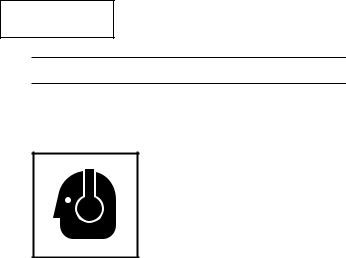
English
SPECIFIC SAFETY RULES AND SYMBOLS
1.Hold tools by insulated gripping surfaces when performing an operation where the tool may contact hidden wiring or its own cord. Contact with a “live” wire will make exposed metal parts of the tool “live” and shock the operator.
2.ALWAYS wear ear protectors when using the tool for extended periods.
Prolonged exposure to high intensity noise can cause hearing loss.
3.Never touch moving parts.
Never place your hands, fingers or other body parts near the tool’s moving parts.
4.Never operate without all guards in place.
Never operate this tool without all guards or safety features in place and in proper working order. If maintenance or servicing requires the removal of a guard or safety feature, be sure to replace the guard or safety feature before resuming operation of the tool.
5.Use right tool.
Don’t force small tool or attachment to do the job of a heavy-duty tool.
Don’t use tool for purpose not intended —for example— don’t use circular saw for cutting tree limbs or logs.
6.Never use a power tool for applications other than those specified.
Never use a power tool for applications other than those specified in the Instruction Manual.
7.Handle tool correctly.
Operate the tool according to the instructions provided herein. Do not drop or throw the tool. Never allow the tool to be operated by children, individuals unfamiliar with its operation or unauthorized personnel.
8.Keep all screws, bolts and covers tightly in place.
Keep all screws, bolts, and plates tightly mounted. Check their condition periodically.
9.Do not use power tools if the plastic housing or handle is cracked.
Cracks in the tool’s housing or handle can lead to electric shock. Such tools should not be used until repaired.
10.Blades and accessories must be securely mounted to the tool.
Prevent potential injuries to youself or others. Blades, cutting implements and accessories which have been mounted to the tool should be secure and tight.
11.Keep motor air vent clean.
The tool’s motor air vent must be kept clean so that air can freely flow at all times. Check for dust build-up frequently.
12.Operate power tools at the rated voltage.
Operate the power tool at voltages specified on its nameplate.
If using the power tool at a higher voltage than the rated voltage, it will result in abnormally fast motor revolution and may damage the unit and the motor may burn
out.
6
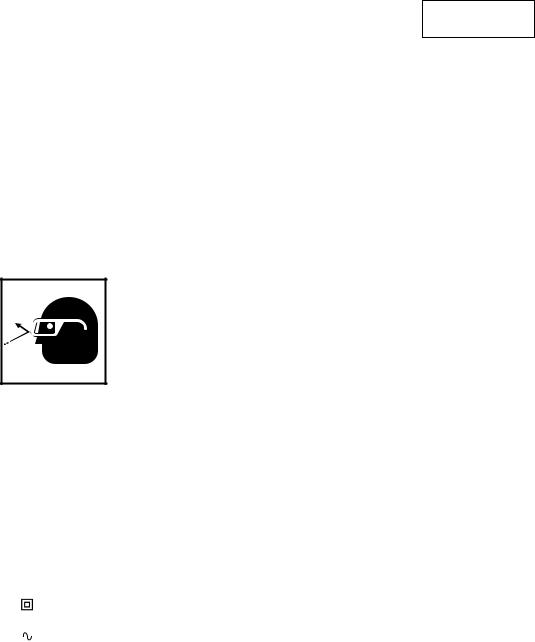
English
13.Never use a tool which is defective or operating abnormally.
If the tool appears to be operating unusually, making strange noises, or otherwise appears defective, stop using it immediately and arrange for repairs by a Hitachi authorized service center.
14.Never leave tool running unattended. Turn power off.
Don’t leave tool until it comes to a complete stop.
15.Carefully handle power tools.
Should a power tool be dropped or struck against hard materials inadvertently, it may be deformed, cracked, or damaged.
16.Do not wipe plastic parts with solvent.
Solvents such as gasoline, thinner benzine, carbon tetrachloride, and alcohol may damage and crack plastic parts. Do not wipe them with such solvents.
Wipe plastic parts with a soft cloth lightly dampened with soapy water and dry thoroughly.
17.ALWAYS wear eye protection that meets the requirement of the latest revision of ANSI
Standard Z87.1.
18.NEVER touch the tool bit with bare hands after operation.
19.NEVER wear gloves made from materials likely to roll up such as cotton, wool, cloth or string, etc.
20.ALWAYS attach the side handle and securely grip the Demolition Hammer.
21.ALWAYS be careful with buried object such as an underground wiring. Touching live wiring or electric cable with this tool may result in electric shock.
Confirm before use whether hidden objects are present, such as electric cables within the wall, floor or ceiling.
22.Definitions for symbols used on this tool V ............. volts
Hz ........... hertz
A ............. amperes
no .......... |
no load speed |
W ............ |
watt |
............ |
Class II Construction |
---/min .... |
revolutions per minute |
........... |
Alternating current |
7

English
DOUBLE INSULATION FOR SAFER OPERATION
To ensure safer operation of this power tool, HITACHI has adopted a double insulation design. “Double insulation” means that two physically separated insulation systems have been used to insulate the electrically conductive materials connected to the power supply from the outer frame handled by the operator. Therefore, either the symbol “ ” or the words and “Double insulation” appear on the power tool or on the nameplate.
” or the words and “Double insulation” appear on the power tool or on the nameplate.
Although this system has no external grounding, you must still follow the normal electrical safety precautions given in this Instruction Manual, including not using the power tool in wet environments.
To keep the double insulation system effective, follow these precautions:
Only HITACHI AUTHORIZED SERVICE CENTER should disassemble or assemble this power tool, and only genuine HITACHI replacement parts should be installed.
Clean the exterior of the power tool only with a soft cloth moistened with soapy water, and dry thoroughly.
Never use solvents, gasoline or thinners on plastic components; otherwise the plastic may dissolve.
SAVE THESE INSTRUCTIONS
AND
MAKE THEM AVAILABLE TO
OTHER USERS
AND
OWNERS OF THIS TOOL!
8
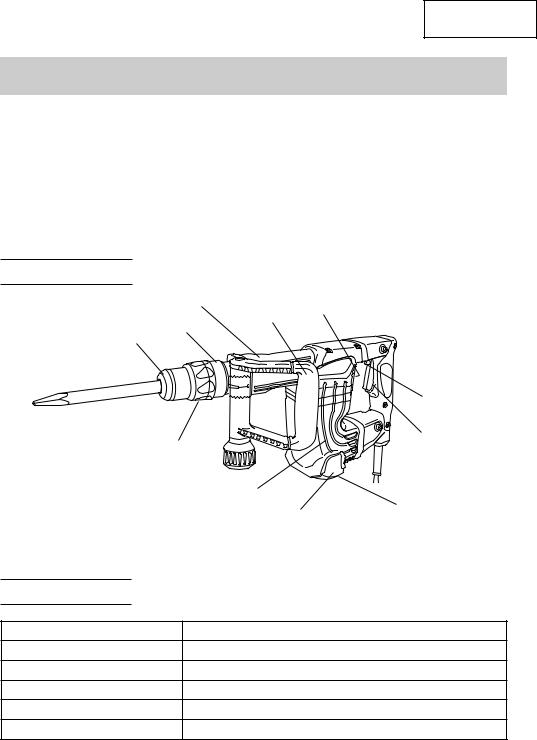
English
FUNCTIONAL DESCRIPTION
NOTE:
The information contained in this Instruction Manual is designed to assist you in the safe operation and maintenance of the power tool.
NEVER operate, or attempt any maintenance on the tool unless you have first read and understood all safety instructions contained in this manual.
Some illustrations in this Instruction Manual may show details or attachments that differ from those on your own power tool.
NAME OF PARTS
Cylinder Case
|
|
Side Handle |
Nameplate |
|
Grip (B) |
|
|
Front Cap |
|
|
|
|
|
|
|
|
|
|
Stopper |
|
|
|
Trigger |
|
Grip (A) |
|
Switch |
|
|
|
|
|
|
Housing |
|
|
|
Brush Cap |
Tail Cover |
|
|
|
|
|
|
(Under the Tail Cover) |
|
|
|
Fig. 1 |
|
SPECIFICATIONS |
|
|
|
Model |
|
|
H 45MR |
Motor |
|
Single-Phase, Series Commutator Motor |
|
Power Source |
|
Single-Phase, 120 V AC 60 Hz |
|
Current |
|
|
8.3 A |
Full-load Impact Rate |
|
|
3000/min. |
Weight |
|
13.0 lbs (5.9 kg) |
|
9

English
ASSEMBLY
 CAUTION: To prevent accidents, make sure to turn the switch off and disconnect the plug from the receptacle.
CAUTION: To prevent accidents, make sure to turn the switch off and disconnect the plug from the receptacle.
NOTE:
When using tools such as bull points, cutters, etc., make sure to use the genuine parts designated by our company.
1. Installing Tools
(1)Clean the shank portion of the tool.
(2)As shown in Fig. 2, pull grip (A) in the direction of A, and insert the tool into a hole of the front cap.
(3)Adjust the groove position while turning the tool, and furthermore insert it until it hits the end of the hole.
(4)Return grip (A) to its original position, pull
the tool to make sure it is locked completely. (Fig. 3)
2.Deciding Working Position of Tool
The tool can be turned every 30 degrees and can be fixed at the position of 12 steps.
(1)As shown in Fig. 4, the blade angle can be freely changed if the grip (A) is turned in the direction of B in a state where grip
(B) is slid in the direction of A.
(2)Release grip (B) and turn the tool, and make sure that it is locked completely.
3.Removing Tool
As shown in Fig. 2, pull grip (A), and pull out the tool.
Grip (A)
A 
Tool
Shank
Front Cap
Fig. 2
Fig. 3
B
A


Grip (A)
Grip (B)
Fig. 4
10
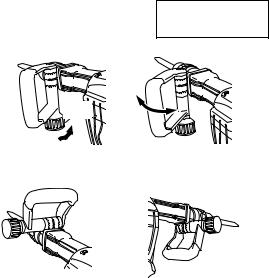
4.Move the side handle
The side handle can be fixed at any
desired position; 360 degrees, and can also be fixed at any position in the back- and-forth direction.
(1)Loosen the handle by turning the grip in the direction of A as shown in Fig. 5.
(2)Adjust it to a position where vertical (up- and-down) operation can be facilitated as illustrated in Fig. 6, Fig. 7, and Fig. 8.
(3)Turn the grip in the direction of B and fix the handle.
English
 Grip
Grip
A B
B
Fig. 5 |
Fig. 6 |
Fig. 7 |
Fig. 8 |
11
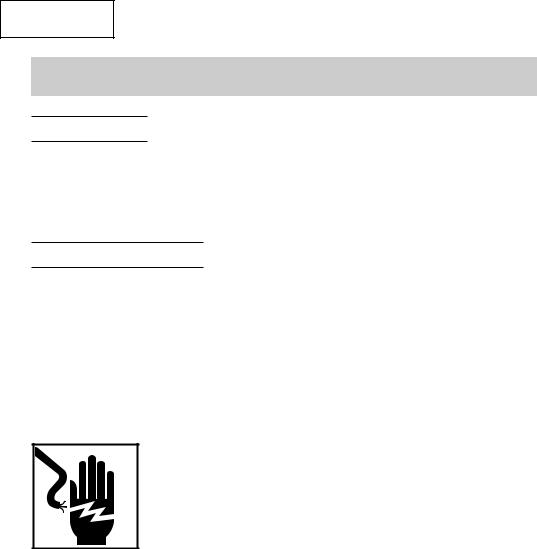
English
OPERATION
APPLICATIONS
Demolishing concrete, chiseling concrete, grooving, bar cutting, and driving piles. Application examples:
Installation of piping and wiring, sanitary facility installation, machinery installation, water supply and drainage work, interior jobs, harbor facilities and other civil engineering work.
PRIOR TO OPERATION
1.Power source
Ensure that the power source to be utilized conforms to the power source requirements specified on the product nameplate.
2.Power switch
Ensure that the switch is in the OFF position. If the plug is connected to a receptacle while the switch is in the ON position, the power tool will start operating immediately and can cause serious injury.
3.Extension cord
When the work area is far away from the power source, use an extension cord of sufficient thickness and rated capacity. The extension cord should be kept as short as practicable.
 WARNING: Damaged cord must be replaced or repaired.
WARNING: Damaged cord must be replaced or repaired.
4.Check the receptacle
If the receptacle only loosely accepts the plug, the receptacle must be repaired. Contact a licensed electrician to make appropriate repairs.
If such a fautly receptacle is used, it may cause overheating, resulting in a serious hazard.
5.Confirming condition of the environment:
Confirm that the work site is placed under appropriate conditions conforming to prescribed precautions.
12
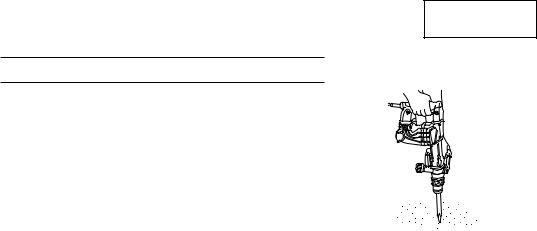
English
HOW TO USE THE DEMOLITION HAMMER
1. After placing the tip of the tool on concrete surface, switch |
|
|
ON. |
|
|
The switch can be turned ON if the trigger is pulled and OFF |
|
|
when it is released. |
|
|
If the stopper is pressed while the trigger for the switch is |
|
|
pulled, even if your finger is released from the trigger, the |
|
|
switch remains ON - convenient for continuous operation. |
|
|
To turn the switch OFF, pull the trigger again, and then the |
|
|
stopper comes off. |
|
|
2. By utilizing the empty weight of the machine and by firmly |
|
|
holding the hammer by both hands, you can effectively |
Fig. 9 |
|
control the subsequent recoil motion. |
||
|
||
Proceed at a moderate work-rate, the use of too much |
|
|
pushing force will impair efficiency. |
|
3.Even when the switch is on, the motor is running and the tool head is pressed to the demolition surface, the hammer sometimes does not start operating. In these instances, turn the switch off, press the tool head against the demolition surface again, and turn the switch on and off. This should start the hammer operating. Repeat this procedure for several minutes, and the hammer will heat, after which it will operate when switched to ON-LOCK.
 CAUTION: After long time of use, the cylinder case becomes hot. Therefore, be careful not to burn your hands.
CAUTION: After long time of use, the cylinder case becomes hot. Therefore, be careful not to burn your hands.
13
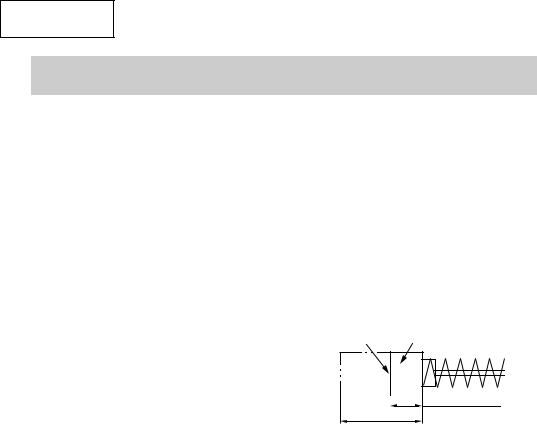
English
MAINTENANCE AND INSPECTION
 WARNING: Be sure to switch power OFF and disconnect the plug from the receptacle during maintenance and inspection.
WARNING: Be sure to switch power OFF and disconnect the plug from the receptacle during maintenance and inspection.
1.Inspecting the tool
Since use of a dull tool will degrade efficiency and cause possible motor malfunction, sharpen or replace the tool as soon as abrasion is noted.
2.Inspecting the screws
Regularly inspect all screws and ensure that they are properly tightened. Should any of the screws be loosened, retighten them immediately.
 WARNING: Using this demolition hammer with loosened screws is extremely dangerous.
WARNING: Using this demolition hammer with loosened screws is extremely dangerous.
3.Inspecting the carbon brushes (Fig. 10)
The Motor employs carbon brushes which are consumable parts. When they become worn to or near the “wear limit”, it could result in motor trouble. When an auto-stop carbon brush is equipped, the motor will stop automatically. At that time, replace both carbon brushes with new ones which have the same carbon brush Numbers shown in the figure. In addition, always keep carbon brushes clean and ensure that they slide freely within the brush holders.
No. of carbon Wear limit brush
73



 0.28" (7 mm)
0.28" (7 mm)
0.67" (17 mm)
Fig. 10
NOTE: Use HITACHI carbon brush No. 73 indicated in Fig. 10.
4.Replacing carbon brushes (Refer to figure for name of parts)
Loosen the set screw then remove the tail cover. By loosening the brush caps, the carbon brushes can be removed. After fitting new carbon brushes, properly retighten the brush caps and mount the tail cover.
5.Grease replacement
This machine is of fully oil sealed construction to protect against dust incursion and to prevent lubricant leakage. This machine can be used without grease replenishment for an extended period of time. However, perform the grease replacement to extend the service life. Replace the grease as described below.
(1)Grease Replacement Period
Inspect the grease amount according to the timing replacement period of the carbon brush. (See item 3 in the section MAINTENANCE AND INSPECTION.)
Ask for grease replacement at the nearest authorized Hitachi Service Center.
In the case that you are forced to change the grease by yourself, please follow the following points.
14
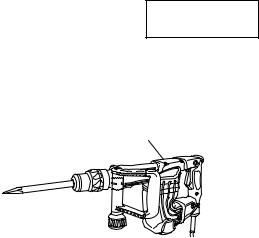
English
(2) How to replace grease
 CAUTION:
CAUTION:
Before replacing the grease, turn the power off and pull out the plug from the receptacle.
1Disassenble the crank cover and thorougly wipe off the old grease inside.
2Supply 1.3 oz (40 g) (the standard volume to cover the connecting rod) of Hitachi Electric Hammer Grease A in the crank
case.
3After replacing the grease, reassemples the crank cover securely. At this time, do not damage or lose the oil seal.
NOTE:
Crank Cover
Fig. 11
The Hitachi Electric Hammer Grease A is of the low viscosity type. When the grease is consumed, purchase from the authorized Hitachi Service Center.
Do not excessively supply the designated amount of grease. Otherwise, the tool should not operate accurately.
6.Service and repairs
All quality power tools will eventually require servicing or replacement of parts because of wear from normal use. To assure that only authorized replacement parts will be used, all service and repairs must be performed by a HITACHI AUTHORIZED SERVICE CENTER, ONLY.
7.Service parts list
A:Item No.
B:Code No.
C:No. Used
D:Remarks
 CAUTION: Repair, modification and inspection of Hitachi Power Tools must be carried out by an Hitachi Authorized Service Center.
CAUTION: Repair, modification and inspection of Hitachi Power Tools must be carried out by an Hitachi Authorized Service Center.
This Parts List will be helpful if presented with the tool to the Hitachi Authorized Service Center when requesting repair or other maintenance. In the operation and maintenance of power tools, the safety regulations and standards prescribed in each country must be observed.
MODIFICATIONS:
Hitachi Power Tools are constantly being improved and modified to incorporate the latest technological advancements.
Accordingly, some parts (i.e. code numbers and/or design) may be changed without prior notice.
15
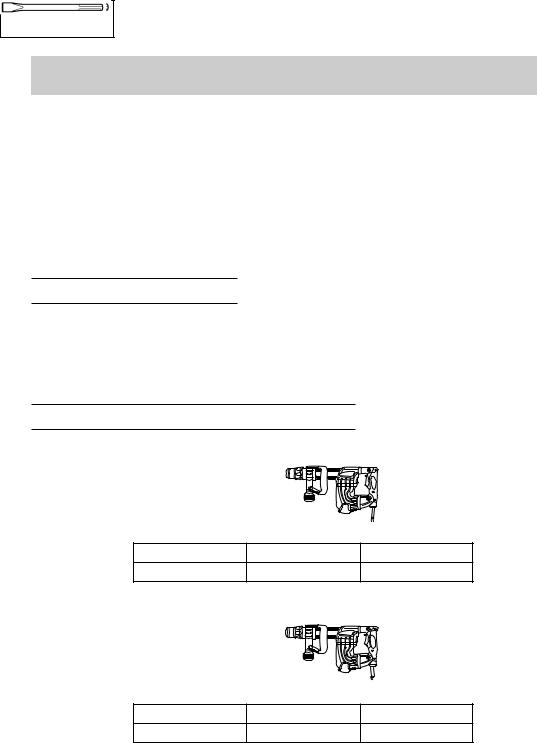
English
ACCESSORIES
 WARNING: ALWAYS use Only authorized HITACHI replacement parts and accessories. NEVER use replacement parts or accessories which are not intended for use with this tool. Contact HITACHI if you are not sure whether it is safe to use a particular replacement part or accessory with your tool.
WARNING: ALWAYS use Only authorized HITACHI replacement parts and accessories. NEVER use replacement parts or accessories which are not intended for use with this tool. Contact HITACHI if you are not sure whether it is safe to use a particular replacement part or accessory with your tool.
The use of any other attachment or accessory can be dangerous and could cause injury or mechanical damage.
NOTE:
Accessories are subject to change without any obligation on the part of the HITACHI.
STANDARD ACCESSORIES
(1) |
Bull Point (SDS max shank) (Code No. 313471)............................................................... |
1 |
(2) |
Case (Code No. 320842) ..................................................................................................... |
1 |
(3) |
Side Handle (Code No. 317103)......................................................................................... |
1 |
(4) |
Allen Wrench (for 6 mm screw) (Code No. 944459) ........................................................ |
1 |
(5) |
Allen Wrench (for 5 mm screw) (Code No. 944458) ........................................................ |
1 |
OPTIONAL ACCESSORIES |
........ sold separately |
|
|
Demolitioning |
|
|
|
(1) |
Bull Point (SDS max shank type) |
|
|
|
Overall Length |
11-1/32" (280 mm) |
15-3/4" (400 mm) |
|
Code No. |
313471 |
313472 |
Groove digging and edging |
|
|
|
(1) |
Cold chisel (SDS max shank type) |
|
|
|
Overall Length |
11-1/32" (280 mm) |
15-3/4" (400 mm) |
|
Code No. |
313473 |
313474 |
16
